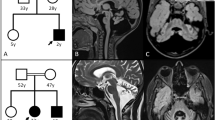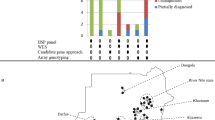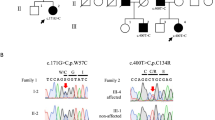Abstract
A heterogeneous group of neurological disorders known as the spinocerebellar ataxias (SCA) are characterized by degeneration of the cerebellum, spinal cord and brainstem. We describe linkage analysis in four unusual SCA families revealing a distinct disease locus on chromosome 3p14–21.1. The disease in these families is distinguished from other forms of SCA by concomitant retinal degeneration. Initial visual problems leading to blindness, disabling ataxia and anticipation are seen in all kindreds. The anticipation in these families suggests a dynamic mutation at this locus. Eventual molecular characterization of this disease may provide valuable insights into the processes of both neural and retinal degeneration.
This is a preview of subscription content, access via your institution
Access options
Subscribe to this journal
Receive 12 print issues and online access
$209.00 per year
only $17.42 per issue
Buy this article
- Purchase on Springer Link
- Instant access to full article PDF
Prices may be subject to local taxes which are calculated during checkout
Similar content being viewed by others
References
Rich, S.S., Wilkie, P., Schut, L., Vance, G. & Orr, H.T. Spinocerebellar ataxia: localization of an autosomal dominant locus between two markers on human chromosome 6. Am. J. hum. Genet. 41, 524–531 (1987).
Gispert, S. et al. Chromosomal assignment of the second locus for autosomal dominant cerebellar ataxia (SCA2) to chromosome 12q23–24.1. Nature Genet. 4, 295–298 (1993).
Stevanin, G. et al. A third locus for autosomal dominant cerebellar ataxia type I maps to chromosome 14q24.37–qter: evidence for the existence of a fourth locus. Am. J. hum. Genet. 54, 11–20 (1994).
Gardner, K. et al. Autosomal dominant spinocerebellar ataxia: clinical description of a distinct hereditary ataxia and genetic localization to chromosome 16 (SCA4) in a Utah kindred. Neurology 44, A361 (1994).
Ranum, L.P.W., Schut, L.J., Lundgren, J.K., Orr, H.T. & Livingston, D.M. Spinocerebellar ataxia type 5 in a family descended from the grandparents of President Lincoln maps to chromosome 11. Nature Genet. 8, 280–284 (1994).
Harding, A.E., (ed.) Clinical features and classification of inherited ataxias (Raven, New York, 1993).
Koningsmark, B.W. & Weiner, L.P. The olivopontocerebellar atrophies: a review. Medicine 49, 227–241 (1970).
Yakura, H., Wakisaka, A., Fujimoto, S. & Itakura, K. Hereditary ataxia and HLA genotypes. New Engl. J. Med. 291, 154–155 (1974).
Jackson, J.F., Currier, R.D., Terasaki, P.I. & Morton, N.E. Spinocerebellar ataxia and HLA linkage: risk prediction by HLA typing. New Engl. J. Med. 296, 1138–1141 (1977).
Zoghbi, H.Y. et al. The gene for autosomal dominant spinocerebellar ataxia (SCA1) maps telomeric to the HLA complex and is closely linked to the D6S89 locus in three large kindreds. Am. J. hum. Genet. 49, 23–30 (1991).
Volz, A., Fonatsh, C. & Ziegler, A. Regional mapping of the gene for autosomal dominant spinocerebellar ataxia (SCA1) by localizing the closely linked D6S89 locus to 6p24.2–23.05. Cytogenet. Cell Genetics. 60, 37–39 (1992).
Kwiatkowski, T.J. et al. The gene for autosomal dominant spinocerebellar ataxia (SCAI) maps centromeric to D6S89 and shows no recombination, in nine large kindreds, with a dinucleotide repeat at the AM10 locus. Am. J. hum. Genet. 53, 391–400 (1993).
Orr, H.T. et al. Expansion of an unstable trinucleotide CAG repeat in spinocerebellar ataxia type I. Nature Genet. 4, 221–226 (1993).
Banfi, S. et al. Identification and characterization of the gene causing type 1 spinocerebellar ataxia. Nature Genet. 7, 513–519 (1994).
Ranum, L.P.W. et al. Autosomal dominant spinocerebellar ataxia: locus heterogeneity in a Nebraska kindred. Neurology 42, 344–347 (1992).
Takiyama, Y. et al. The gene for Machado- Joseph disease maps to human chromosome 14q. Nature Genet. 4, 300–304 (1993).
St George-Hyslop, P. et al. Machado-Joseph disease in pedigrees of Azorean descent is linked to chromosome 14. Am. J. hum. Genet. 55, 120–125 (1994).
Gouw, L.G., Digre, K.B., Harris, C.P., Haines, J.H. & Ptacek, L.J. Autosomal dominant cerebellar ataxia with retinal degeneration: clinical, neuropathologic and genetic analysis of a large kindred. Neurology 44, 1441–1447 (1994).
Ott, J. Analysis of Human Genetic Linkage (Johns Hopkins University Press, Baltimore, 1991).
Lopes-Cendes, I., Andermann, E. & Rouleau, G.A. Evidence for the existence of a fourth dominantly inherited spinocerebellar ataxia locus. Genomics 21, 270–274 (1994).
Twells, R. et al. Autosomal dominant cerebellar ataxia with dementia: evidence for a fourth disease locus. Hum. molec. Genet. 3, 177–180 (1994).
Benomar, A. et al. Autosomal dominant cerebellar ataxia with retinal degeneration (ADCA type II) is genetically different from ADCA type I. Ann. Neurol. 35, 439–444 (1994).
To, K.W., Adamian, M., Jakobiec, F.A. & Berson, E.L. Olivopontocerebellar atrophy with retinal degeneration: an electroretinographic and histopathologic investigation. Ophthalmology 100, 15–23 (1993).
La Spada, A.R., Wilson, E.M., Lubahn, D.B., Harding, A.E. & Fishbeck, K.H. Androgen receptor gene mutations in X-linked spinal and bulbar muscular atrophy. Nature 352, 77–79 (1991).
A novel gene containing a trinucleotide repeat that is expanded and unstable on Huntington's disease chromosomes. Cell 72, 971–983 (1993).
Koide, R. et al. Unstable expansion of CAG repeat in hereditary dentatorubral-pallidoluysian atrophy (DRPLA). Nature Genet. 6, 9–13 (1994).
Nagafuchi, S. et al. Dentatorubral and pallidoluysian atrophy expansion of an unstable CAG trinucleotide on chromosome 12p. Nature Genet. 6, 14–18 (1994).
Burke, J.R. et al. The Haw River Syndrome: dentatorubropallidoluysian atrophy (DRPLA) in an African-American family. Nature Genet. 7, 521–524 (1994).
Kawaguchi, Y. et al. CAG expansions in a novel gene for Machado-Joseph disease at chromosome 14q32.1. Nature Genet. 8, 221–227 (1994).
Ptacek, L.J. et al. Sodium channel mutations in paramyotonia congenita and hyperkalemic periodic paralysis. Ann. Neurol. 33, 300–307 (1993).
Bell, G.I., Karam, J. & Rutter, W. Polymorphic DNA region adjacent to the 5′ end of the human insulin gene. Proc. natn. Acad. Sci. U.S.A. 78, 5759–5763 (1981).
Murray, J.C. et al. A comprehensive human linkage map with centimorgan density. Cooperative Human Linkage Center (CHLC). Science 265, 2049–2054 (1994).
Gyapay, G. et al. The 1993–1994 Généthon human genetic linkage map. Nature Genet. 7, 246–339 (1994).
Lathrop, G.M., Lalouel, J.M., Julier, C. & Ott, J. Strategies for multilocus linkage analysis in humans. Proc. natn. Acad. Sci. U.S.A. 81, 3443–3446 (1984).
Author information
Authors and Affiliations
Rights and permissions
About this article
Cite this article
Gouw, L., Kaplan, C., Haines, J. et al. Retinal degeneration characterizes a spinocerebellar ataxia mapping to chromosome 3p. Nat Genet 10, 89–93 (1995). https://doi.org/10.1038/ng0595-89
Received:
Accepted:
Issue Date:
DOI: https://doi.org/10.1038/ng0595-89
This article is cited by
-
Founder Effects of Spinocerebellar Ataxias in the American Continents and the Caribbean
The Cerebellum (2020)
-
Molecular Targets and Therapeutic Strategies in Spinocerebellar Ataxia Type 7
Neurotherapeutics (2019)
-
Ophthalmic features of spinocerebellar ataxia type 7
Eye (2018)
-
CAG repeat disorder models and human neuropathology: similarities and differences
Acta Neuropathologica (2007)
-
Retinitis pigmentosa, pigmentary retinopathies, and neurologic diseases
Current Neurology and Neuroscience Reports (2006)



